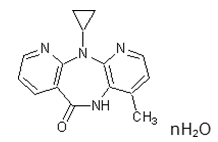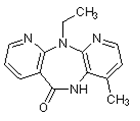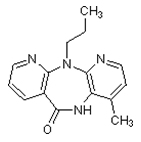Monographs: Pharmaceutical substances: Nevirapine (Nevirapinum)

n = 0 (anhydrous)
n = ½ (hemihydrate)
Anhydrous: C15H14N4O; hemihydrate: C15H14N4O . ½ H2O.
Relative molecular mass. Anhydrous: 266.3; hemihydrate: 275.3.
Chemical name. Anhydrous: 11-cyclopropyl-4-methyl-5,11-dihydro-6H-dipyrido[3,2-b:2',3'-e][1,4]diazepin-6-one; 11-cyclopropyl-5,11-dihydro-4-methyl -6H-dipyrido[3,2-b:2',3'-e][1,4]diazepin-6-one; CAS Reg. N° 129618-40-2; hemihydrate: 11-cyclopropyl-4-methyl-5,11-dihydro-6H-dipyrido[3,2-b:2',3'-e][1,4]diazepin-6-one hemihydrate; 11-cyclopropyl-5,11-dihydro-4-methyl-6H-dipyrido[3,2-b:2',3'-e][1,4]diazepin-6-one, hydrate (2:1); CAS Reg. N° 220988-26-1.
Description. A white to almost white powder.
Solubility. Practically insoluble in water, sparingly to slightly soluble in dichloromethane R, slightly soluble in methanol R.
Category. Antiretroviral (Non-Nucleoside Reverse Transcriptase Inhibitor).
Storage. Nevirapine should be kept in a well-closed container.
Labelling. The designation on the container should state whether the substance is the hemihydrate or is in the anhydrous form.
Requirements
Definition. Nevirapine contains not less than 98.0% and not more than 102.0% of nevirapine (C15H14N4O), calculated with reference to the anhydrous substance.
Identity tests
• Either tests A and B or test C may be applied.
A. Carry out test A.1 or, where UV detection is not available, test A.2.
A.1 Carry out the test as described under 1.14.1 Chromatography, Thin-layer chromatography, using silica gel R6 as the coating substance and a mixture of 90 volumes of dichloromethane R, 10 volumes of methanol R and 3 volumes of glacial acetic acid R as the mobile phase. Apply separately to the plate 5 μl of each of the following two solutions in methanol R. For solution (A) use 5 mg of the test substance per mL. For solution (B) use 5 mg of nevirapine RS per mL. After removing the plate from the chromatographic chamber allow it to dry exhaustively in air or in a current of cool air. Examine the chromatogram in ultraviolet light (254 nm).
The principal spot obtained with solution A corresponds in position, appearance and intensity with that obtained with solution B.
A.2 Carry out the test as described under 1.14.1 Chromatography, Thin-layer chromatography, using the conditions described above under test A.1 but using silica gel R5 as the coating substance. Spray the plate with basic potassium permanganate (~1 g/l) TS. Examine the chromatogram in daylight.
The principal spot obtained with solution (A) corresponds in position, appearance and intensity with that obtained with solution (B).
B. The absorption spectrum (1.6) of a 10 μg/mL solution in methanol R, when observed between 220 nm and 350 nm, exhibits a maximum at about 283 nm with a specific absorbance (
), calculated with reference to the anhydrous substance, between 251 and 285.
C. Carry out the examination as described under 1.7 Spectrophotometry in the infrared region. For the anhydrous substance the infrared absorption spectrum is concordant with the spectrum obtained from nevirapine RS or with the reference spectrum of nevirapine. For the hemihydrate the infrared absorption spectrum shows a characteristic sharp absorbance at about 3503 cm-1; after heating the test substance for one hour at 140 °C and cooling the infrared absorption spectrum is concordant with the spectrum obtained from nevirapine RS or with the reference spectrum of nevirapine.
Sulfated ash (2.3). Not more than 1.0 mg/g.
Water. Determine as described under 2.8 Determination of water by the Karl Fischer method, Method A. For the anhydrous form use about 1 g of the test substance; the water content is not more than 2 mg/g. For the hemihydrate use about 0.30 g of the test substance; the water content is not less than 31 mg/g and not more than 39 mg/g.
Related substances
Prepare fresh solutions and perform the tests without delay. Carry out the test as described under 1.14.1 Chromatography, High-performance liquid chromatography, using the chromatographic conditions given under Assay.
Prepare solution A as follows: dissolve 12 mg of nevirapine RS in 2 mL of acetonitrile R, add 40 mL of the mobile phase and sonicate. Dilute to 50.0 mL with the mobile phase.
Prepare the following solutions. For solution (1) dissolve 24 mg of the test substance in 4 mL of acetonitrile R, add 80 mL of the mobile phase and sonicate. Dilute to 100.0 mL with the mobile phase. For solution (2) dilute 5.0 mL of solution (1) to 50.0 mL with the mobile phase. Dilute 5.0 mL of this solution to 50.0 mL with the same solvent. For solution (3) dissolve 6 mg of nevirapine impurity B RS in a mixture of 25 mL of acetonitrile R and 55 mL of mobile phase, sonicate for 30 minutes and dilute to 100.0 mL with the mobile phase. Mix 6.0 mL of this solution with 3.0 mL of solution (A) and dilute to 50.0 mL with the mobile phase.
Inject 50 μl of solution (3). The test is not valid unless the resolution between nevirapine and nevirapine impurity B RS is not less than 5. In the chromatogram obtained with solution (3) the peak due to impurity B is eluted at a relative retention of about 0.7 with reference to nevirapine (retention time about 7.6 minutes).
Inject separately 50 μl of solution (2). The test is not valid unless the column efficiency determined for nevirapine using solution (2) is not less than 10 000. The peak symmetry factor of nevirapine should be between 0.8 and 1.2.
Inject separately 50 μl each of solution (1) and of the mobile phase and record the chromatograms for six times the retention time of nevirapine. Examine the blank chromatogram for any extraneous peaks and disregard the corresponding peaks observed in the chromatogram obtained with solution (1).
In the chromatogram obtained with solution (1) the area of any individual peak corresponding to impurity B, when multiplied by a correction factor of 0.77, is not greater than 0.2 times the area of the principal peak in the chromatogram obtained with solution (2) (0.2%).The area of any other impurity peak is not greater than 0.2 times the area of the principal peak in the chromatogram obtained with solution (2) (0.2%) and the area of not more than two such peaks is greater than 0.1 times the area of the principal peak in the chromatogram obtained with solution (2) (0.1%). The sum of the areas of all peaks, other than the principal peak, is not greater than 0.6 times the area of the principal peak in the chromatogram obtained with solution (2) (0.6 %). Disregard any peak with an area less than 0.05 times the area of the principal peak obtained with solution (2) (0.05%).
Assay
Prepare fresh solutions and perform the tests without delay. Carry out the test as described under 1.14.1 Chromatography, High-performance liquid chromatography, using a stainless steel column (15 cm x 4.6 mm), packed with particles of silica gel, the surface of which has been modified with chemically bonded hexadecylamidylsilyl groups (5 μm). As the mobile phase use a filtered and degassed mixture of 20 volumes of acetonitrile R and 80 volumes of a 3.6 g/l solution of ammonium dihydrogen phosphate R adjusted to pH 5.0 using ammonia (~260 g/l) TS.
Operate with a flow rate of 1.0 mL per minute. As a detector use an ultraviolet spectrophotometer set at a wavelength of about 220 nm.
Maintain the column temperature at 35 °C.
Prepare solution A as follows: dissolve 12 mg of nevirapine RS in 2 mL of acetonitrile R, add 40 mL of the mobile phase and sonicate. Dilute to 50.0 mL with the mobile phase.
Prepare the following solutions. For solution (1) dissolve about 24 mg of the test substance, accurately weighed, in 4 mL of acetonitrile R, add 80 mL of the mobile phase and sonicate. Dilute to 100.0 mL with the mobile phase. Dilute 3.0 mL of this solution to 25.0 mL with the mobile phase. For solution (2) dilute 3.0 mL of solution A to 25.0 mL with the mobile phase. For solution (3) dissolve 6 mg of nevirapine impurity B RS in a mixture of 25 mL of acetonitrile R and 55 mL of mobile phase, sonicate for 30 minutes and dilute to 100.0 mL with the mobile phase. Mix 6.0 mL of this solution with 3.0 mL of solution (A) and dilute to 50.0 mL with the mobile phase.
Inject 50 μl of solution (3). The test is not valid unless the resolution between nevirapine and nevirapine impurity B RS is not less than 5. In the chromatogram obtained with solution (3) the peak due to impurity (B) is eluted at a relative retention of about 0.7 with reference to nevirapine (retention time about 7.6 minutes).
Inject separately 50 μl of solution (2). The test is not valid unless the column efficiency determined for nevirapine using solution (2) is not less than 10 000. The peak symmetry factor of nevirapine should be between 0.8 and 1.2.
Inject separately 50 μl each of solution (1) and of the mobile phase and record the chromatograms for six times the retention time of nevirapine.
Measure the areas of the peaks responses obtained in the chromatograms from solutions (1) and (2) and calculate the content of nevirapine (C15H14N4O) with reference to the anhydrous substance.
Impurities

A. 11-ethyl-4-methyl-5,11-dihydro-6H-dipyrido[3,2-b:2',3':e][1,4]diazepin-6-one,

B. 4-methyl-5,11-dihydro-6H-dipyrido[3,2-b:2',3':e][1,4]diazepin-6-one,

C. 4-methyl-11-propyl-5,11-dihydro-6H-dipyrido[3,2-b:2',3':e][1,4]diazepin-6-one.